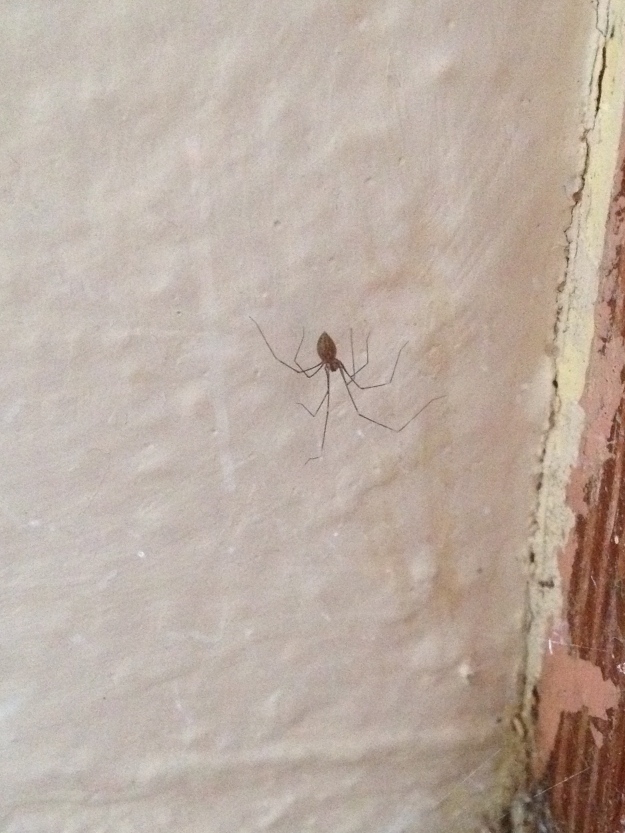Autumn news in UK is full of scary spider stories because that’s the time of year they all come in from the cold. It made me smile to read one such in a Bermuda paper – a possible sighting of black widow spiders on the benches outside the new hospital wing. The government entomologist has declared them to be brown widow with a less painful nip – so that’s alright then!
Last year, on one of my first exploration rambles I almost had a full blown panic as I walked into a huge sticky web connecting two branches at least 3 feet apart, with a very scary-looking spiky spider sitting in the centre:
Locally they call it a crab spider, for obvious reasons; it is a spiny backed orb weaving spider.
Did you know that the eponymous spider in Charlotte’s Web was an orb weaver? The author, EB White, spent some time living on Bermuda and it would have been a romantic connection if he had got the idea from these crab spiders, but it is more likely he saw the related barn spiders in his own childhood home and Charlottes “full name” in the book was “Charlotte Aranea Cavatica” linking her to another species of orb weavers.
The big spider in the centre is the female and somewhere near the edge a male or two will be biding his time for an opportunity to mate with her, a process reported to take up to 35 minutes. Sadly six hour’s later he pops his clogs and even the female only lives long enough to secure her egg sac under a low lying leafy plant. The teenage crab spiders wait in the undergrowth until they are big enough and scary enough to build webs out in the open – the appearance is all bluff, they are not poisonous and don’t bite.
If you want a poisonous spider on Bermuda then clean out the warm dark cupboards or sheds: the brown recluse likes to hide in cardboard boxes and shoes ( one reason I may invest in plastic shoe boxes). They aren’t good at web design and their tangled chaotic creations don’t catch much so they go out to hunt at night. They are not endemic to Bermuda, rather expats with work permits – they will eat cockroaches, so that’s a reason to leave them alone and let them live their reclusive lives. If you do get bitten then you probably need to seek medical advice because up to 50% of bites will turn nasty, some becoming necrotic. However, such bites are really not common – nothing in local news until you go back some 6 years. To identify your brown recluse it will have only 6 eyes and on its back a dark pattern in the shape of a violin, hence its common name “fiddleback”.

Brown Recluse Spider By Ladyb695 (Own work) [CC-BY-SA-3.0 (http://creativecommons.org/licenses/by-sa/3.0)%5D, via Wikimedia Commons

Wolf Spider By Bidgee (Own work) [CC-BY-SA-3.0 (http://creativecommons.org/licenses/by-sa/3.0)%5D, via Wikimedia Commons
But far more likely inside your house will be “Daddy-Long-Legs” spiders – not the crane flies that the British identify as DLL, but leggy fast moving harmless spiders whose untidy webs rely on an element of confusion and panic rather than any stickiness or strength to catch prey. These are useful spiders – they eat ants, albeit leaving the residue husk in a give-away pile on the floor under the web, but that has to be better than trying to track the source of a long line of ants with the nasty-smelling insecticide spray poised for attack.
That leaves just the wonderfully named “golden silk spider“, huge and quite scary looking with a colourful abdomen and hairy legs – you have to look up, they hang webs in trees, high up when the weather is good, low down when storms are on the way – hence their common name “hurricane spiders”. Their webs are huge, maybe a metre across with even longer support strands so they can span across the width of a Bermudian road. I have been out these past two days trying to get a photo of one but I guess there could be a storm coming as there are none to be seen. (If I can find a photo with Creative Commons rights then it will be here:

Golden Silk Spider By http://www.birdphotos.com (Own work) [CC-BY-3.0 (http://creativecommons.org/licenses/by/3.0)%5D, via Wikimedia Commons
So finding a non-native black widow spider queueing for hospital outpatients is an unusual occurrence, even if it was brown, not black.
Bermuda definitely does not have “spiders large as saucers lurking in the dresser” (JK Rowling, Harry Potter #5)


